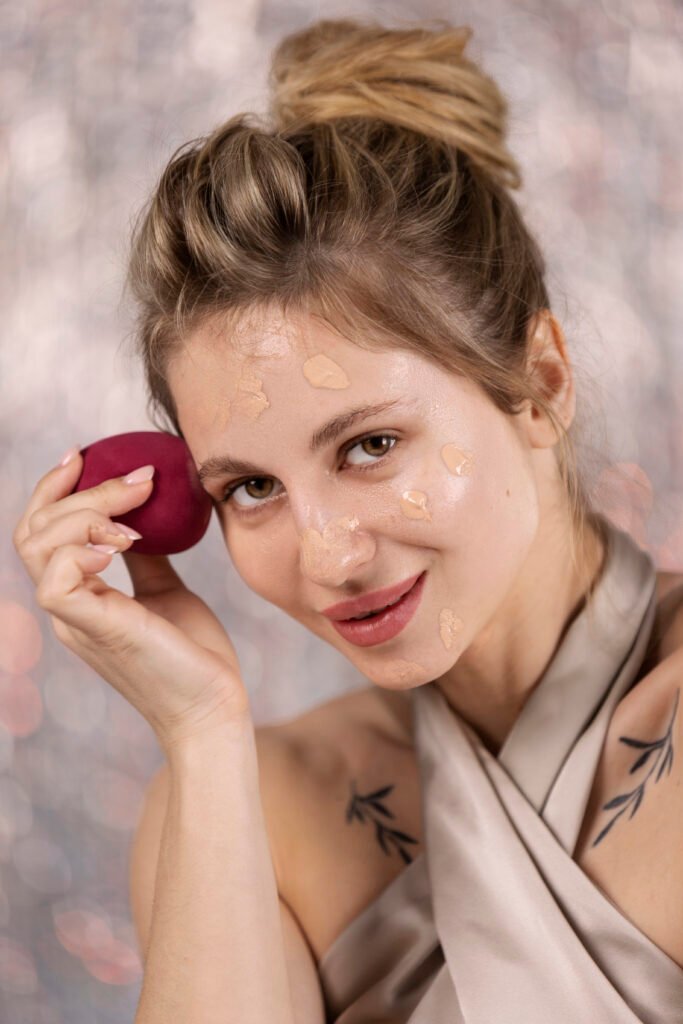Foundation is a fundamental cosmetic that helps create an even skin tone and prepares the face for the rest of your makeup. It’s a staple in many beauty routines, designed to enhance your natural appearance and provide a flawless finish. With options like liquid, powder, and cream, foundation suits a variety of skin types and personal styles.
Knowing how to use it well can significantly improve your overall makeup look and boost your self-esteem.
Whether you’re after a full-coverage effect or a light, natural glow, foundation is a reliable choice for achieving a smooth, radiant complexion tailored to your needs.
Introduction To Foundation Makeup
Foundation is a key part of most beauty routines, acting as the base layer for the rest of your makeup. Whether you’re going for a light, natural look or a more full-coverage style, choosing the right foundation can greatly impact your overall appearance.
So, what is foundation, and why does it matter so much? Let’s explore its significance
Importance Of Foundation
Foundation is more than just a beauty product. It’s the base upon which all other makeup is applied. A good foundation evens out your skin tone, covers imperfections, and gives you a fresh, polished look.
Without foundation, other makeup products like blush, bronzer, and highlighter won’t stand out as effectively. Foundation helps these products adhere better and last longer. It’s a must-have for anyone looking to create a flawless finish.
Brief History Of the Foundation
The foundation has come a long way from its early days. Ancient Egyptians used a mix of lead and ochre to lighten their skin. This practice was not only harmful but also far from the smooth, blendable products we have today.
In the 1930s, Max Factor introduced the first commercially available foundation. It was a game-changer. Since then, the beauty industry has seen countless innovations, from liquid to powder to stick foundations.
Today, foundations come in various formulas to suit different skin types and preferences. Whether you have oily, dry, or combination skin, there’s a foundation out there for you.
Have you found your perfect foundation yet? If not, what challenges are you facing? Share in the comments below!
Types Of Foundation Makeup
Foundation makeup is essential for a flawless look. It comes in various types. Each type suits different skin types and preferences. Let’s explore the main types of foundation makeup.
Liquid Foundation
Liquid foundation is the most popular. It offers buildable coverage. This means you can apply more layers for a fuller look. It works well for dry, normal, and combination skin. Liquid foundation blends easily. It provides a smooth finish. Some formulas also offer hydrating benefits.
Powder Foundation
Powder foundation is lightweight. It is perfect for oily or acne-prone skin. This foundation helps control shine. It gives a matte finish. Powder foundation is easy to apply. You can use a brush or sponge. It’s great for quick touch-ups during the day.
Cream Foundation
Cream foundation offers full coverage. It is thicker than liquid foundation. This type is ideal for dry or mature skin. Cream foundation provides a dewy finish. It keeps the skin hydrated. Apply it with a brush or sponge for the best results.
Stick Foundation
Stick foundation is convenient. It is easy to carry and apply. This type offers medium to full coverage. It works well for normal to oily skin. Stick foundation can also be used as a concealer. It is perfect for on-the-go touch-ups.
Choosing The Right Shade
Foundation makeup helps even out skin tone. Choosing the right shade ensures a natural look and enhances your complexion. Test shades on your jawline for the best match.
Choosing the right shade of foundation makeup can be tricky. But it’s essential for a flawless look. Here’s how to nail it.
Understanding Skin Undertones
Identifying your skin’s undertone is essential when selecting the right foundation shade. Undertones typically fall into three categories: warm, cool, and neutral. Warm undertones often have a yellow or golden tint, while cool undertones show hints of pink or blue. Neutral undertones are a balanced blend of the two. An easy way to check your undertone is by examining the color of your veins. If they look green, you likely have warm undertones; if they appear blue or purple, your undertones are cool. A combination of both usually indicates a neutral undertone.
Swatching Techniques
Testing foundation shades properly is crucial to finding your perfect match. Instead of applying it to your wrist or hand, try swiping a few shades along your jawline for a more accurate result. Blend them in and check how they look in natural lighting—your ideal shade should disappear into your skin without any visible edges. Taking a photo can also help you see how it appears on camera. Still feeling unsure? Get a second opinion from a friend or seek advice from a makeup professional. Picking the right foundation can truly elevate your entire makeup look. Application Techniques Foundation makeup can be a game-changer for your beauty routine, but applying it correctly is key. Different techniques can help you achieve a flawless look. Let’s dive into some of the most popular methods: using brushes, sponges, and your fingers.
Using Brushes
Applying foundation with a brush can provide a smooth, even finish. Choose a brush with densely packed bristles for better coverage.
Start by dabbing a small amount of foundation on the back of your hand. Then, dip the brush into the product and apply it to your face using circular motions.
Remember to blend well, especially around the jawline and hairline. This technique helps avoid any harsh lines and ensures a natural look.
Using Sponges
Sponges are perfect for a dewy, airbrushed finish. Wet your sponge slightly to prevent it from absorbing too much product.
Apply foundation in dots across your face. Use the sponge to gently press and blend the product into your skin.
This method is great for building up coverage. You can layer the foundation without it looking cakey.
Using Fingers
Using your fingers can give you a more natural, skin-like finish. The warmth of your hands helps the foundation blend seamlessly.
Take a small amount of foundation and dot it on your forehead, cheeks, nose, and chin. Use your fingers to blend it outwards in small, circular motions.
This technique is perfect for quick touch-ups and when you’re on the go. Just make sure your hands are clean to avoid any breakouts.
Have you tried these techniques? Which one works best for you? Share your experiences in the comments below!
Preparing Your Skin
Foundation makeup provides a base for other makeup products. It creates an even skin tone, hiding imperfections and enhancing natural beauty. Proper skin preparation ensures foundation looks smooth and lasts longer.
Preparing Your Skin Before you dive into the world of foundation makeup, it’s crucial to prepare your skin. Proper skin preparation not only ensures a smooth application but also helps your makeup last longer. Think of it as setting the stage for your masterpiece.
Cleansing
Start with a clean slate. Wash your face using a gentle cleanser suited to your skin type. This removes dirt, oil, and impurities that can affect your makeup’s finish. Cleansing should be a daily habit. It keeps your skin healthy and prevents breakouts. Don’t skip this step, even if you’re in a hurry.
Moisturizing
Hydration is key. Apply a good moisturizer that matches your skin type—whether it’s oily, dry, or combination. Moisturizing helps in creating a smooth canvas for your foundation. Think of your skin as a sponge. Hydrated skin absorbs makeup better, reducing the chances of a cakey look. If you have dry skin, opt for a richer formula. For oily skin, a lightweight gel works wonders.
Priming
Priming is often overlooked but can make a huge difference. A good primer fills in pores and fine lines, offering a smooth base for your foundation. It also controls oil and helps your makeup stay put. Choose a primer that addresses your specific concerns. If you have redness, go for a color-correcting primer. For those with large pores, a pore-filling primer can be a game-changer. Have you ever wondered why your makeup looks flawless one day and patchy the next? The secret often lies in these preparatory steps. Don’t underestimate their power. Ready to give it a try? You’ll be amazed at the difference a few extra minutes can make. Happy prepping!
Setting Foundation Makeup
Locking in your foundation is essential for maintaining a smooth, long-lasting finish. It helps keep your makeup in place all day. There are two primary ways to set your foundation: with a setting powder or a setting spray. Both techniques offer unique advantages. Let’s take a closer look at each option.
Using Setting Powder
Setting powder is a classic choice. It helps absorb excess oil. It also minimizes shine. Lightly dust the powder over your foundation. Use a fluffy brush for even coverage. Focus on areas that tend to get oily. Think forehead, nose, and chin.
Choose a translucent powder. It blends well with any foundation shade. This prevents your makeup from looking cakey. It also gives a natural finish. If you have dry skin, use less powder. This helps avoid a dry or flaky appearance.
Using Setting Spray
Setting spray is perfect for a dewy finish. It’s simple to use. Hold the bottle about 8-10 inches from your face. Close your eyes and mist evenly. Let it dry naturally. It locks your makeup in place. It also provides a fresh, radiant look.
Setting spray is great for all skin types. It hydrates dry skin. It controls oil for oily skin. Choose a spray that suits your needs. Some offer extra hydration. Others offer a matte finish. Experiment to find the best one for your skin.
Foundation For Different Skin Types
Choosing the right foundation makeup can be tricky. Everyone has different skin types and needs. Using the wrong foundation can lead to issues. Understanding your skin type helps in selecting the best product. Here is a guide to help you choose the right foundation for your skin type.
Oily Skin
People with oily skin should pick a matte foundation. Matte foundations help control shine. Look for oil-free formulas. These foundations reduce the appearance of pores. Powder foundations work well too. They absorb excess oil. Avoid liquid foundations with a dewy finish.
Dry Skin
Dry skin needs hydration. Choose a hydrating foundation. Look for words like “moisturizing” or “hydrating” on the label. Liquid or cream foundations work best. They provide moisture and do not flake. Avoid powder foundations. They can make dry skin look worse.
Combination Skin
Combination skin has both oily and dry areas. A balancing foundation is key. Use a foundation that offers a satin finish. This type provides a balance between matte and dewy. Apply powder on oily areas. Use a hydrating primer on dry patches. This helps in achieving an even look.
Sensitive Skin
Sensitive skin needs gentle products. Choose a foundation with fewer ingredients. Look for hypoallergenic or fragrance-free labels. Mineral foundations are a good choice. They are gentle and often have soothing properties. Test the product on a small area first. This ensures it does not cause a reaction.
Common Mistakes And How To Avoid Them
Foundation makeup is a staple in many beauty routines. Yet, common mistakes can hinder achieving a flawless look. Understanding and avoiding these errors can enhance your makeup application.
Over-application
Applying too much foundation can lead to a cakey appearance. Start with a small amount. Build coverage gradually. Use a damp sponge or brush. Blend thoroughly to avoid excess.
Wrong Shade
Choosing the wrong shade is a frequent mistake. Test foundation on your jawline. Natural light reveals true color. Match your skin tone, not your hand. A perfect shade blends seamlessly.
Skipping Primer
Skipping primer can affect foundation longevity. Primer creates a smooth base. It helps foundation adhere better. Choose a primer suitable for your skin type. It ensures a lasting finish.
Top Foundation Brands
Foundation makeup evens out the skin tone, creating a smooth base for other cosmetics. Top foundation brands offer formulas for all skin types. These brands ensure long-lasting coverage and a flawless finish.
When it comes to foundation makeup, choosing the right brand can make a world of difference. With so many options available, it can be overwhelming to decide which one is best suited for your skin type and needs. Let’s break down some of the top foundation brands that cater to different preferences and budgets.
High-end Brands
High-end foundations are often praised for their luxurious formulas and extensive shade ranges. Brands like Estée Lauder are renowned for their Double Wear Stay-in-Place Makeup, which offers long-lasting coverage that doesn’t budge. Dior’s Forever Foundation is another favorite, known for its flawless finish and comfortable wear. You might also want to consider Giorgio Armani’s Luminous Silk Foundation. It provides a natural, radiant finish that feels like second skin. These high-end brands often come with a higher price tag, but the investment can be worth it for the quality and performance.
Drugstore Brands
If you’re on a budget, don’t worry! There are plenty of drugstore foundations that deliver excellent results.
Maybelline’s Fit Me Matte + Poreless Foundation is a cult favorite, offering a matte finish with a wide range of shades to match various skin tones.
L’Oréal’s True Match Foundation is another excellent choice, known for its blendable formula and natural finish.
Revlon’s ColorStay Foundation is perfect for those seeking long-lasting coverage without breaking the bank.
These drugstore brands prove that you don’t have to spend a fortune to achieve a flawless base. — Have you ever wondered why some foundations work better for you than others? It’s often about finding the right brand that matches your skin type and preferences. Have you tried any of these top brands? Share your experiences and help others make an informed choice!
Frequently Asked Questions
What Does Foundation Makeup Do?
Foundation helps create an even complexion and hides flaws, offering a smooth surface for applying the rest of your makeup.
Is Foundation Really Necessary For Makeup?
Foundation is essential for makeup. It creates a smooth base, evens out skin tone, and enhances makeup longevity.
What’s The Difference Between Concealer And Foundation?
Concealer targets specific areas to cover blemishes and dark circles. Foundation evens out skin tone over the entire face. Both create a flawless base.
When Should I Use Foundation?
Use foundation to even out your skin tone, cover imperfections, and create a smooth base for makeup. Apply it before concealer and other products.
Conclusion
Foundation makeup is essential for a flawless look. It evens out skin tone. It also hides imperfections. Finding the right foundation type is crucial. Consider your skin type and coverage needs. Testing shades on your jawline helps match your skin.
Remember, less is more for a natural finish. Practice makes perfect. Experiment with different tools. Brushes, sponges, and fingers all work. Foundation makeup can boost your confidence. Enjoy the process.








